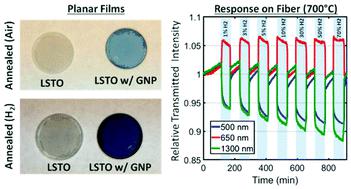Our official English website, www.x-mol.net, welcomes your feedback! (Note: you will need to create a separate account there.)
Combined plasmonic Au-nanoparticle and conducting metal oxide high-temperature optical sensing with LSTO.
Nanoscale ( IF 6.7 ) Pub Date : 2020-06-25 , DOI: 10.1039/d0nr03306e Jeffrey K Wuenschell 1 , Youngseok Jee 1 , Derek K Lau 2 , Yang Yu 3 , Paul R Ohodnicki 3
Nanoscale ( IF 6.7 ) Pub Date : 2020-06-25 , DOI: 10.1039/d0nr03306e Jeffrey K Wuenschell 1 , Youngseok Jee 1 , Derek K Lau 2 , Yang Yu 3 , Paul R Ohodnicki 3
Affiliation

|
Fiber optic sensor technology offers several advantages for harsh-environment applications. However, the development of optical gas sensing layers that are stable under harsh environmental conditions is an ongoing research challenge. In this work, electronically conducting metal oxide lanthanum-doped strontium titanate (LSTO) films embedded with gold nanoparticles are examined as a sensing layer for application in reducing gas flows at high temperature (600–800 °C). A strong localized surface plasmon resonance (LSPR) based response to hydrogen is demonstrated in the visible region of the spectrum, while a Drude free electron-based response is observed in the near-IR. Characteristics of these responses are studied both on planar glass substrates and on silica fibers. Charge transfer between the oxide film and the gold nanoparticles is explored as a possible mechanism governing the Au LSPR response and is considered in terms of the corresponding properties of the conducting metal oxide-based matrix phase. Principal component analysis is applied to the combined plasmonic and free-carrier based response over a range of temperatures and hydrogen concentrations. It is demonstrated that the combined visible and near-IR response of these films provides improved versatility for multiwavelength interrogation, as well as improved discrimination of important process parameters (concentration and temperature) through application of multivariate analysis techniques.
中文翻译:

结合等离激元金纳米粒子和利用LSTO进行金属氧化物高温光学传感。
光纤传感器技术为恶劣环境的应用提供了许多优势。然而,开发在恶劣环境条件下稳定的光学气体传感层是一项持续的研究挑战。在这项工作中,将嵌入金纳米颗粒的导电金属氧化物掺杂镧的钛酸锶(LSTO)膜作为传感层进行了研究,以用于降低高温(600–800°C)的气体流量。在光谱的可见光区域证实了对氢的强局部表面等离子体共振(LSPR)响应,而在近红外中观察到了基于德鲁德自由电子的响应。在平板玻璃基板和二氧化硅纤维上都研究了这些响应的特性。氧化膜和金纳米颗粒之间的电荷转移被研究为控制Au LSPR响应的一种可能机制,并考虑了基于导电金属氧化物的基体相的相应性质。主成分分析适用于在一定温度和氢气浓度范围内基于等离子体和自由载体的组合响应。结果表明,这些薄膜的可见光和近红外响应相结合,通过多变量分析技术的应用,提高了多波长询问的通用性,并改善了重要工艺参数(浓度和温度)的辨别力。主成分分析适用于在一定温度和氢气浓度范围内基于等离子体和自由载体的组合响应。结果表明,这些薄膜的可见光和近红外响应相结合,通过多变量分析技术的应用,提高了多波长询问的通用性,并改善了重要工艺参数(浓度和温度)的辨别力。主成分分析适用于在一定温度和氢气浓度范围内基于等离子体和自由载体的组合响应。结果表明,这些薄膜的可见光和近红外响应相结合,通过多变量分析技术的应用,提高了多波长询问的通用性,并改善了重要工艺参数(浓度和温度)的辨别力。
更新日期:2020-07-16
中文翻译:

结合等离激元金纳米粒子和利用LSTO进行金属氧化物高温光学传感。
光纤传感器技术为恶劣环境的应用提供了许多优势。然而,开发在恶劣环境条件下稳定的光学气体传感层是一项持续的研究挑战。在这项工作中,将嵌入金纳米颗粒的导电金属氧化物掺杂镧的钛酸锶(LSTO)膜作为传感层进行了研究,以用于降低高温(600–800°C)的气体流量。在光谱的可见光区域证实了对氢的强局部表面等离子体共振(LSPR)响应,而在近红外中观察到了基于德鲁德自由电子的响应。在平板玻璃基板和二氧化硅纤维上都研究了这些响应的特性。氧化膜和金纳米颗粒之间的电荷转移被研究为控制Au LSPR响应的一种可能机制,并考虑了基于导电金属氧化物的基体相的相应性质。主成分分析适用于在一定温度和氢气浓度范围内基于等离子体和自由载体的组合响应。结果表明,这些薄膜的可见光和近红外响应相结合,通过多变量分析技术的应用,提高了多波长询问的通用性,并改善了重要工艺参数(浓度和温度)的辨别力。主成分分析适用于在一定温度和氢气浓度范围内基于等离子体和自由载体的组合响应。结果表明,这些薄膜的可见光和近红外响应相结合,通过多变量分析技术的应用,提高了多波长询问的通用性,并改善了重要工艺参数(浓度和温度)的辨别力。主成分分析适用于在一定温度和氢气浓度范围内基于等离子体和自由载体的组合响应。结果表明,这些薄膜的可见光和近红外响应相结合,通过多变量分析技术的应用,提高了多波长询问的通用性,并改善了重要工艺参数(浓度和温度)的辨别力。


























 京公网安备 11010802027423号
京公网安备 11010802027423号